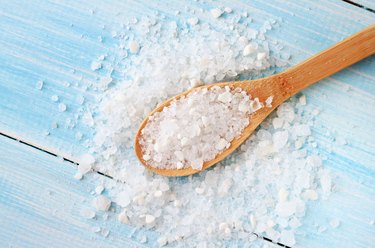
You've probably heard of people limiting their salt intake or maybe of athletes trying to increase the amount of sodium they consume. But contrary to popular belief, sodium is not synonymous with salt.
"Salt is a mineral that is made up of sodium and chloride," Isabel Smith, RD, CDN, tells LIVESTRONG.com.
"It's the sodium in salt that can be worse for our health." So while "salt" can refer to a host of different chemicals, "sodium" refers to just a part of that salt, Monica Auslander Moreno, RD, LDN, a nutrition consultant for RSP Nutrition, explains.
How Much Sodium Is in Salt
A single teaspoon of salt contains 2,325 milligrams of sodium.
How Much Sodium Should You Have in a Day?
The Dietary Guidelines for Americans recommend getting no more than 2,300 milligrams of sodium a day (so, almost as much as what's in a single teaspoon of salt). However, the American Heart Association (AHA) recommends most adults limit their intake to even less than that, consuming no more than 1,500 milligrams of sodium per day.
This reduced recommendation is especially important for people who are at higher risk for conditions exacerbated by excess sodium. This includes people above the age of 51, those with high blood pressure, diabetes or chronic kidney disease and African Americans, according to Iowa State University.
Most of us, it turns out, are eating a whole lot more sodium than health experts recommend. On average, Americans get around 3,400 mg of the stuff each day, according to the AHA.
And those who abstain from the salt shaker aren't exempt. Just about 71 percent of the sodium in Americans' diets comes from packaged foods and restaurant meals, a May 2017 study published in the journal Circulation found.
Why You Should Be Worried About Getting Too Much Sodium
Diets with excess sodium are linked to a host of health risks. "Too much sodium can contribute to dehydration, hypertension [a risk factor associated with heart disease], stroke, kidney disease and osteoporosis," Moreno says.
Those who took in more sodium were observed to have higher blood pressure levels than people who consumed less, an August 2014 study published in the New England Journal of Medicine that analyzed the urine sodium levels of more than 100,000 people from 18 countries found.
What's more, getting too much salt may also have a negative effect on the immune system. A March 2020 study published in Science Translational Medicine suggests that consuming more than five grams of salt (or 2,000 milligrams of sodium) per day poses a risk to one's immunity.
The study was primarily performed on mice, that, when fed a high-salt diet, suffered from more severe bacterial infections — but several human volunteers who took in an additional six grams of salt (or 2,400 milligrams of sodium) per day also showed potential impaired response to bacterial infection.
But, Your Body Needs Some Sodium
Sodium isn't inherently bad; in fact, our bodies need it — in small amounts — to carry out daily functions.
"Sodium does have vital metabolic functions but we really need only about 500 milligrams a day minimally for these to occur," Moreno explains. Sodium helps the body transmit nerve impulses, maintain the proper balance of fluids in the body and helps control the contraction and relaxation of muscles.
For people with heart failure, getting too much sodium (around 2,800 to 3,000 milligrams per day) or too little (under 1,900 milligrams per day) was linked to higher mortality rates, according to an Academy of Nutrition and Dietetics Evidence Analysis Library systematic review.
How the Body Gets Rid of Excess Sodium
Your body knows what to do with excess sodium, but only up to a point.
"Drinking water is always a good idea, but drinking more won't necessarily flush out extra amounts of sodium."
"Water intake can help dilute sodium and flush it out, yes, but it will never eliminate all salt from your body (which is a dangerous condition called hyponatremia)," Moreno says. In a normal, healthy body, the kidneys respond to extra sodium and flush it out through the urine, Smith adds.
Drinking water is always a good idea, but drinking more won't necessarily flush out extra amounts of sodium.
Eating potassium-rich foods has been shown to help the body manage a sodium overload. Foods that are a source of potassium include dried fruit, lentils, yogurt, salmon, chicken (white meat), spinach, soy, broccoli, tomatoes, bananas and potatoes.
However, it's important to consult your doctor before upping your potassium intake, especially if you deal with kidney complications or take certain high blood pressure medications.
Related Reading
Foods With Little to No Sodium
One way to cut back on sodium is to eat more low-sodium foods. These include:
- Fruits
- Vegetables
- Unprocessed meats and fish
- Whole grains
- Dried beans
- Unsalted nuts and seeds
- Healthy oils (all oils are virtually salt-free, but you'll want to choose heart-healthy options)
"Most fruits and vegetables have some sodium," explains Smith, "but they also have potassium that helps to balance it out."
You'll also find trace amounts of sodium in salt-free legumes, avocado, olive oil, salt-free nuts and seeds, eggs and flesh proteins, Moreno says, adding that there's no need to entirely rid your diet of the element.
Cooking at home can help reduce your salt intake, but you'll want to be wary of your seasonings. If you're used to using flavor boosters like garlic salt, onion salt, MSG, soy sauce, teriyaki sauce, barbecue sauce, olives, pickles and croutons, you may want to start experimenting with some less-salty options.
Consider oranges, lemons, vinegars and herbs your new flavor-adding friends.
Tip
These 11 delicious spices make it easy to hold the salt, stock up and start sprinkling.